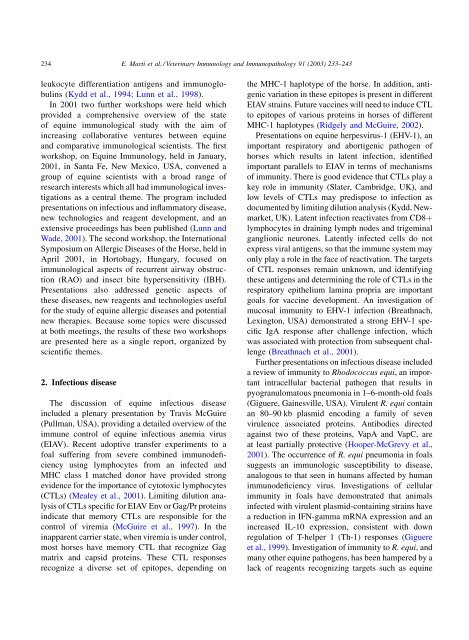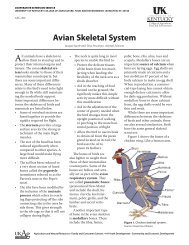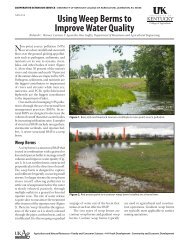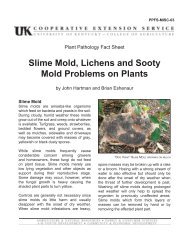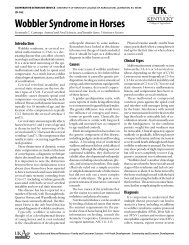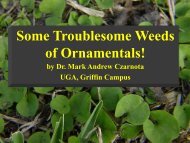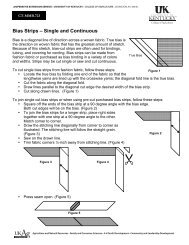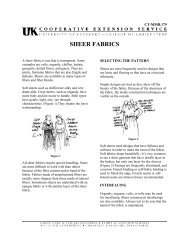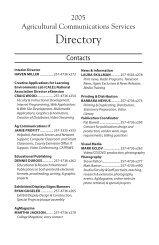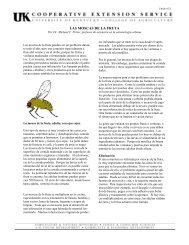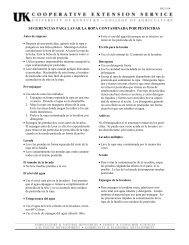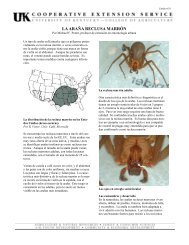Advances in equine immunology: Havemeyer workshop reports from ...
Advances in equine immunology: Havemeyer workshop reports from ...
Advances in equine immunology: Havemeyer workshop reports from ...
Create successful ePaper yourself
Turn your PDF publications into a flip-book with our unique Google optimized e-Paper software.
234 E. Marti et al. / Veter<strong>in</strong>ary Immunology and Immunopathology 91 (2003) 233±243<br />
leukocyte differentiation antigens and immunoglobul<strong>in</strong>s<br />
(Kydd et al., 1994; Lunn et al., 1998).<br />
In 2001 two further <strong>workshop</strong>s were held which<br />
provided a comprehensive overview of the state<br />
of equ<strong>in</strong>e immunological study with the aim of<br />
<strong>in</strong>creas<strong>in</strong>g collaborative ventures between equ<strong>in</strong>e<br />
and comparative immunological scientists. The ®rst<br />
<strong>workshop</strong>, on Equ<strong>in</strong>e Immunology, held <strong>in</strong> January,<br />
2001, <strong>in</strong> Santa Fe, New Mexico, USA, convened a<br />
group of equ<strong>in</strong>e scientists with a broad range of<br />
research <strong>in</strong>terests which all had immunological <strong>in</strong>vestigations<br />
as a central theme. The program <strong>in</strong>cluded<br />
presentations on <strong>in</strong>fectious and <strong>in</strong>¯ammatory disease,<br />
new technologies and reagent development, and an<br />
extensive proceed<strong>in</strong>gs has been published (Lunn and<br />
Wade, 2001). The second <strong>workshop</strong>, the International<br />
Symposium on Allergic Diseases of the Horse, held <strong>in</strong><br />
April 2001, <strong>in</strong> Hortobagy, Hungary, focused on<br />
immunological aspects of recurrent airway obstruction<br />
(RAO) and <strong>in</strong>sect bite hypersensitivity (IBH).<br />
Presentations also addressed genetic aspects of<br />
these diseases, new reagents and technologies useful<br />
for the study of equ<strong>in</strong>e allergic diseases and potential<br />
new therapies. Because some topics were discussed<br />
at both meet<strong>in</strong>gs, the results of these two <strong>workshop</strong>s<br />
are presented here as a s<strong>in</strong>gle report, organized by<br />
scienti®c themes.<br />
2. Infectious disease<br />
The discussion of equ<strong>in</strong>e <strong>in</strong>fectious disease<br />
<strong>in</strong>cluded a plenary presentation by Travis McGuire<br />
(Pullman, USA), provid<strong>in</strong>g a detailed overview of the<br />
immune control of equ<strong>in</strong>e <strong>in</strong>fectious anemia virus<br />
(EIAV). Recent adoptive transfer experiments to a<br />
foal suffer<strong>in</strong>g <strong>from</strong> severe comb<strong>in</strong>ed immunode®ciency<br />
us<strong>in</strong>g lymphocytes <strong>from</strong> an <strong>in</strong>fected and<br />
MHC class I matched donor have provided strong<br />
evidence for the importance of cytotoxic lymphocytes<br />
(CTLs) (Mealey et al., 2001). Limit<strong>in</strong>g dilution analysis<br />
of CTLs speci®c for EIAV Env or Gag/Pr prote<strong>in</strong>s<br />
<strong>in</strong>dicate that memory CTLs are responsible for the<br />
control of viremia (McGuire et al., 1997). In the<br />
<strong>in</strong>apparent carrier state, when viremia is under control,<br />
most horses have memory CTL that recognize Gag<br />
matrix and capsid prote<strong>in</strong>s. These CTL responses<br />
recognize a diverse set of epitopes, depend<strong>in</strong>g on<br />
the MHC-1 haplotype of the horse. In addition, antigenic<br />
variation <strong>in</strong> these epitopes is present <strong>in</strong> different<br />
EIAV stra<strong>in</strong>s. Future vacc<strong>in</strong>es will need to <strong>in</strong>duce CTL<br />
to epitopes of various prote<strong>in</strong>s <strong>in</strong> horses of different<br />
MHC-1 haplotypes (Ridgely and McGuire, 2002).<br />
Presentations on equ<strong>in</strong>e herpesvirus-1 (EHV-1), an<br />
important respiratory and abortigenic pathogen of<br />
horses which results <strong>in</strong> latent <strong>in</strong>fection, identi®ed<br />
important parallels to EIAV <strong>in</strong> terms of mechanisms<br />
of immunity. There is good evidence that CTLs play a<br />
key role <strong>in</strong> immunity (Slater, Cambridge, UK), and<br />
low levels of CTLs may predispose to <strong>in</strong>fection as<br />
documented by limit<strong>in</strong>g dilution analysis (Kydd, Newmarket,<br />
UK). Latent <strong>in</strong>fection reactivates <strong>from</strong> CD8‡<br />
lymphocytes <strong>in</strong> dra<strong>in</strong><strong>in</strong>g lymph nodes and trigem<strong>in</strong>al<br />
ganglionic neurones. Latently <strong>in</strong>fected cells do not<br />
express viral antigens, so that the immune system may<br />
only play a role <strong>in</strong> the face of reactivation. The targets<br />
of CTL responses rema<strong>in</strong> unknown, and identify<strong>in</strong>g<br />
these antigens and determ<strong>in</strong><strong>in</strong>g the role of CTLs <strong>in</strong> the<br />
respiratory epithelium lam<strong>in</strong>a propria are important<br />
goals for vacc<strong>in</strong>e development. An <strong>in</strong>vestigation of<br />
mucosal immunity to EHV-1 <strong>in</strong>fection (Breathnach,<br />
Lex<strong>in</strong>gton, USA) demonstrated a strong EHV-1 speci®c<br />
IgA response after challenge <strong>in</strong>fection, which<br />
was associated with protection <strong>from</strong> subsequent challenge<br />
(Breathnach et al., 2001).<br />
Further presentations on <strong>in</strong>fectious disease <strong>in</strong>cluded<br />
a review of immunity to Rhodococcus equi, an important<br />
<strong>in</strong>tracellular bacterial pathogen that results <strong>in</strong><br />
pyogranulomatous pneumonia <strong>in</strong> 1±6-month-old foals<br />
(Giguere, Ga<strong>in</strong>esville, USA). Virulent R. equi conta<strong>in</strong><br />
an 80±90 kbplasmid encod<strong>in</strong>g a family of seven<br />
virulence associated prote<strong>in</strong>s. Antibodies directed<br />
aga<strong>in</strong>st two of these prote<strong>in</strong>s, VapA and VapC, are<br />
at least partially protective (Hooper-McGrevy et al.,<br />
2001). The occurrence of R. equi pneumonia <strong>in</strong> foals<br />
suggests an immunologic susceptibility to disease,<br />
analogous to that seen <strong>in</strong> humans affected by human<br />
immunode®ciency virus. Investigations of cellular<br />
immunity <strong>in</strong> foals have demonstrated that animals<br />
<strong>in</strong>fected with virulent plasmid-conta<strong>in</strong><strong>in</strong>g stra<strong>in</strong>s have<br />
a reduction <strong>in</strong> IFN-gamma mRNA expression and an<br />
<strong>in</strong>creased IL-10 expression, consistent with down<br />
regulation of T-helper 1 (Th-1) responses (Giguere<br />
et al., 1999). Investigation of immunity to R. equi, and<br />
many other equ<strong>in</strong>e pathogens, has been hampered by a<br />
lack of reagents recogniz<strong>in</strong>g targets such as equ<strong>in</strong>e


